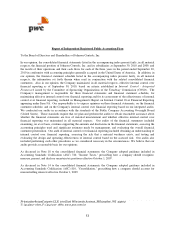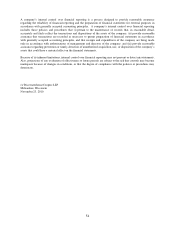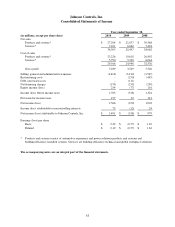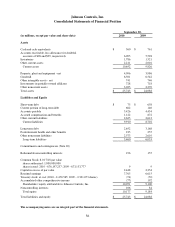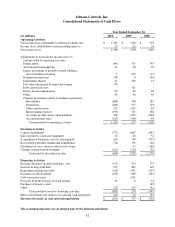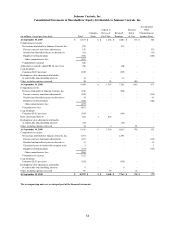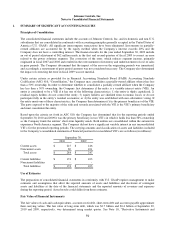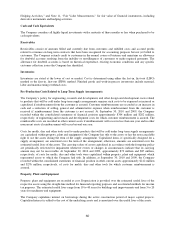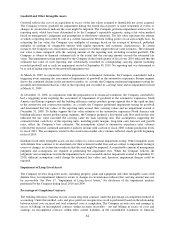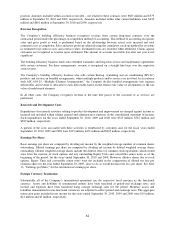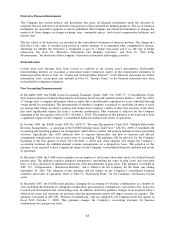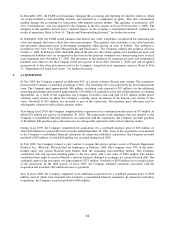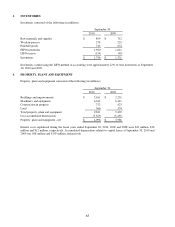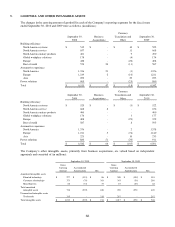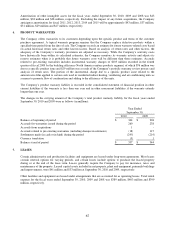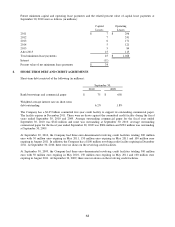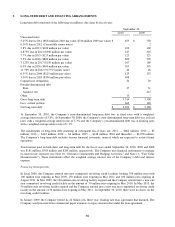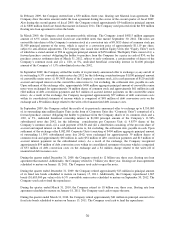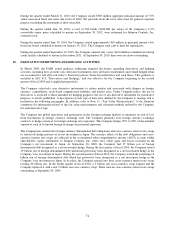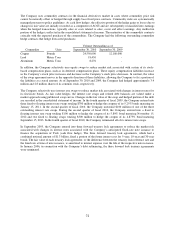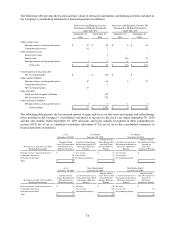Johnson Controls 2010 Annual Report Download - page 63
Download and view the complete annual report
Please find page 63 of the 2010 Johnson Controls annual report below. You can navigate through the pages in the report by either clicking on the pages listed below, or by using the keyword search tool below to find specific information within the annual report.63
Derivative Financial Instruments
The Company has written policies and procedures that place all financial instruments under the direction of
corporate treasury and restrict all derivative transactions to those intended for hedging purposes. The use of financial
instruments for speculative purposes is strictly prohibited. The Company uses financial instruments to manage the
market risk from changes in foreign exchange rates, commodity prices, stock-based compensation liabilities and
interest rates.
The fair values of all derivatives are recorded in the consolidated statements of financial position. The change in a
derivative’s fair value is recorded each period in current earnings or accumulated other comprehensive income,
depending on whether the derivative is designated as part of a hedge transaction and if so, the type of hedge
transaction. See Note 10, ―Derivative Instruments and Hedging Activities,‖ and Note 11, ―Fair Value
Measurements,‖ for disclosure of the Company’s derivative instruments and hedging activities.
Reclassification
Certain prior year amounts have been revised to conform to the current year’s presentation. Redeemable
noncontrolling interests are classified as mezzanine equity (temporary equity) in the consolidated statements of
financial position. Refer to Note 14, ―Equity and Noncontrolling Interests,‖ to the financial statements for further
information. Also, certain prior year amounts in Note 18, ―Income Taxes,‖ to the financial statements have been
reclassified for comparative purposes.
New Accounting Pronouncements
In December 2009, the FASB issued Accounting Standards Update (ASU) No. 2009-17, ―Consolidations (Topic
810): Improvements to Financial Reporting by Enterprises Involved with Variable Interest Entities.‖ ASU No. 2009-
17 changes how a company determines when an entity that is insufficiently capitalized or is not controlled through
voting should be consolidated. The determination of whether a company is required to consolidate an entity is based
on, among other things, an entity’s purpose and design and a company’s ability to direct the activities of the entity
that most significantly impact the entity’s economic performance. This statement is effective for the Company
beginning in the first quarter of fiscal 2011 (October 1, 2010). The adoption of this guidance is not expected to have
a significant impact on the Company’s consolidated financial condition and results of operations.
In October 2009, the FASB issued ASU No. 2009-13, ―Revenue Recognition (Topic 605): Multiple-Deliverable
Revenue Arrangements – a consensus of the FASB Emerging Issues Task Force.‖ ASU No. 2009-13 establishes the
accounting and reporting guidance for arrangements under which a vendor will perform multiple revenue-generating
activities. Specifically, this ASU addresses how to separate deliverables and how to measure and allocate
arrangement consideration to one or more units of accounting. This guidance will be effective for the Company
beginning in the first quarter of fiscal 2011 (October 1, 2010) and, when adopted, will change the Company’s
accounting treatment for multiple-element revenue arrangements on a prospective basis. The adoption of this
guidance is not expected to have a significant impact on the Company’s consolidated financial condition and results
of operations.
In December 2008, the FASB issued guidance on an employer’s disclosures about plan assets of a defined benefit
pension plan. The guidance requires enhanced transparency surrounding the types of plan assets and associated
risks, as well as disclosure of information about fair value measurements of plan assets. This guidance is included in
ASC 715, ―Compensation – Retirement Benefits,‖ and is effective for the Company for the fiscal year ending
September 30, 2010. The adoption of this guidance did not impact on the Company’s consolidated financial
condition and results of operations. Refer to Note 15, ―Retirement Plans,‖ for the Company’s disclosures of plan
assets.
In December 2007, the FASB issued guidance changing the accounting for business combinations in a number of
areas including the treatment of contingent consideration, preacquisition contingencies, transaction costs, in-process
research and development and restructuring costs. In addition, under this guidance changes in an acquired entity’s
deferred tax assets and uncertain tax positions after the measurement period will impact income tax expense. This
guidance is included in ASC 805, ―Business Combinations,‖ and was adopted by the Company in the first quarter of
fiscal 2010 (October 1, 2009). This guidance changes the Company’s accounting treatment for business
combinations on a prospective basis.


